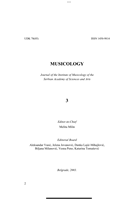Retro-garde, Dazzlement and Isolation: Searching for Musical Identities. Conference on musical identities held in August 2002 in Amsterdam
Retro-garde, Dazzlement and Isolation: Searching for Musical Identities. Conference on musical identities held in August 2002 in Amsterdam
Author(s): Albert van der SchootSubject(s): Music, Conference Report, Sociology of Art, History of Art
Published by: Muzikološki institut SANU
Keywords: conference report; Conference on musical identities held in August 2002 in Amsterdam; Musicology;
Summary/Abstract: The twentieth century saw a development in the arts that had never occurred before in history. Producers and recipients of art grew totally apart. Traditionally, the production of art had always been dependent on commissions and public. Around 1900, production began to precede the interest of potential commissioners, spectators and audiences. In music, the gap was wider than in the pictorial arts: it did not take the museums more than a few decades to catch up with the cubists, the surrealists, and the other painters who took leave from traditional depiction based on the rules of central perspective. But the composers who challenged the rules of the musical equivalent of central perspective, ‘central tonality’, suffered a different fate. Even today, a symphony orchestra runs the risk of not attracting enough listeners when putting too much Schoenberg or Webern on the programme. Should that be a reason to restrict the diet of the audiences to Bach, Mozart and Mahler? Almost any professional in music will resist this. So will any government agency responsible for the creation and diffusion of artistic products. But here, we face a paradox: since political decisions on the funding for the orchestra may depend on the immediate attractiveness of the programmes for the audience, political demands for specific quota of new music on the programme create a tension between introducing ‘new’ music to the concert audience (and the label neue Musik continues to be used here and there for music dating from before the Second World War) and the very conditions for the survival of the musical body required to bring any new music to life.
Journal: Muzikologija
- Issue Year: 1/2003
- Issue No: 3
- Page Range: 240-244
- Page Count: 5
- Language: English

